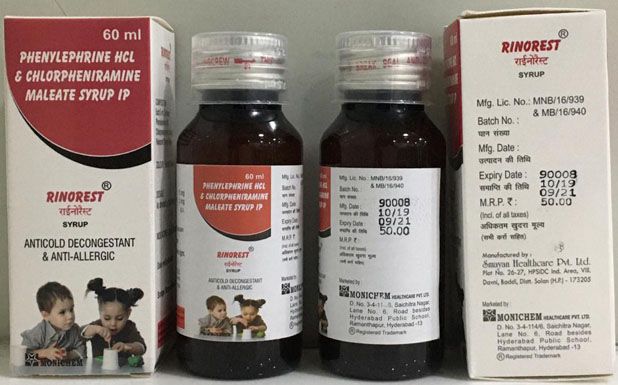Chlorpheniramine Maleate and Phenylephrine Syrup
Each 5 ml contains:
Chlorpheniramine Maleate 2 mg
Phenylephrine 5 mg
Chlorpheniramine Maleate 2 mg
Phenylephrine 5 mg
The syrup contains decongestant Phenylephrine and an antihistamine Chlorpheniramine maleate. Combination is used to relieve symptoms caused by the common cold, allergies, flu, or other breathing illnesses (such as sinusitis, bronchitis). Watery eyes, itchy eyes/nose/throat, runny nose, and sneezing can be treated using antihistamines.
- Allergic Rhinitis
- Fever
- Nasal congestion
- Relief of sinus pain and headache
Mechanism of action:
Phenylephrine is categorized as sympathomimetic drug and mimics the actions of epinephrine (commonly known as adrenaline) or norepinephrine. Phenylephrine selectively binds to alpha-1 receptors which cause blood vessels to constrict leads to nasal decongestant action.Chlorpheniramine maleate acts on histamine H1 receptor as an inverse agonist. It structurally resembles the ethanolamine class of antihistaminergic agents. By antagonising the effects of histamine on the capillaries, it can reduce the tenseness of allergic symptoms. It also acts centrally as it crosses the blood–brain barrier and inversely agonizes the H1 receptors which can result in drowsiness.
Pharmacokinetics:
Phenylephrine: When orally administered, the bioavailability was found to be 38%. Peak concentration reaches between 0.5 and 2 hours after administration. No protein‐binding data in humans are available. It undergoes extensive biotransformation in the gut wall and the liver. Half‐lives is relatively short, approximately 2.5 hours. Reduced metabolism of Phenylephrine occurs with concurrent administration of monoamine oxidase inhibitors.Chlorpheniramine maleate: It is well orally absorbed with protein binding of 72%. It is majorly metabolised in liver and is excreted in urine with a half-life of 21 to 27 hours.
- Tachycardia
- Palpitations
- Headache
- Dizziness
- Nausea
- Anxiety
- Restlessness
- Tremor
- Weakness
- Dysuria
- Insomnia
- Hallucinations
- Convulsions.
- Taking this with alcohol can cause liver damage.
- Consuming the following along with any other sedative medication may cause excessive drowsiness.
- The drug is generally safe to use while driving. However, if you feel dizziness or drowsiness, driving is not recommended.
- Should also be avoided by people with hypersensitivity.
- Formulation is not safe for people with renal diseases or renal failure. Get doctor’s advice in case of renal-related disorders.
